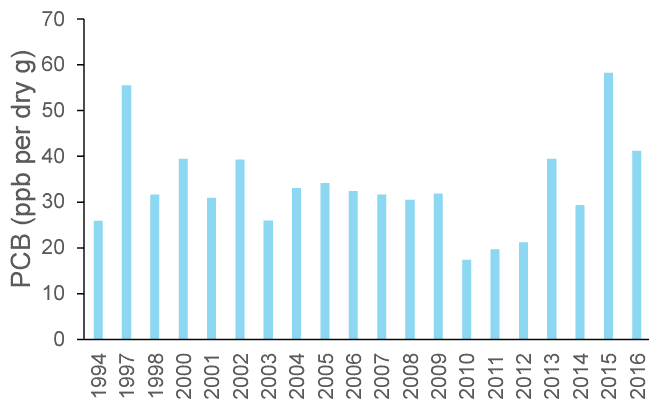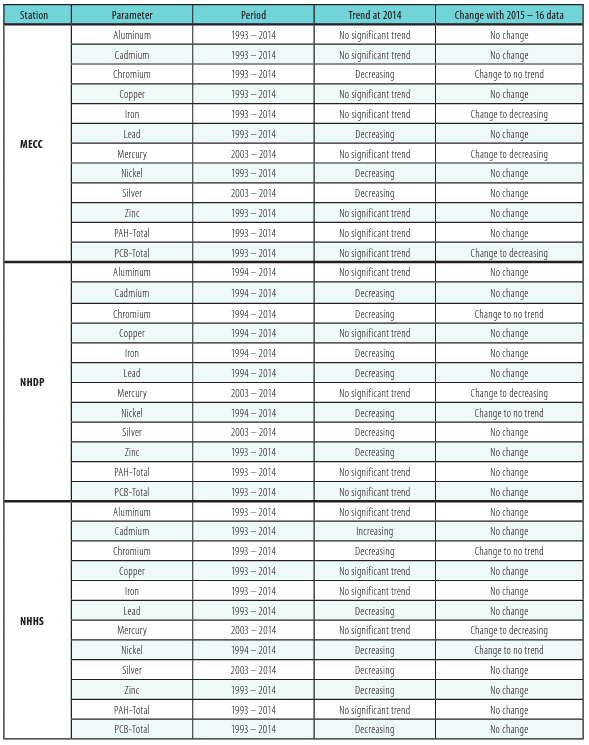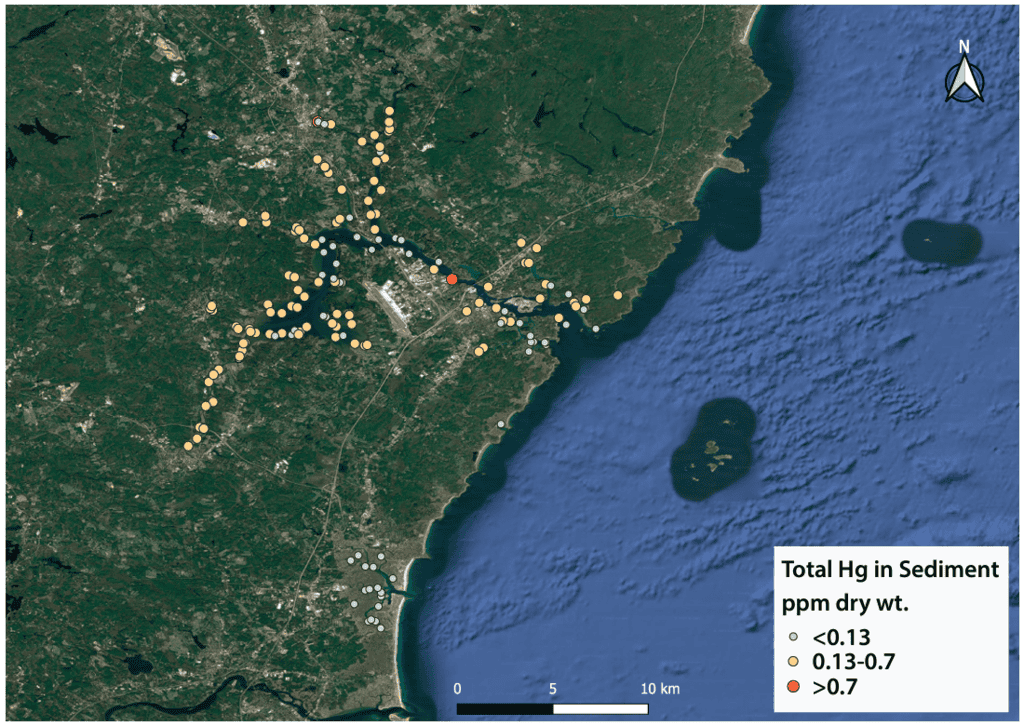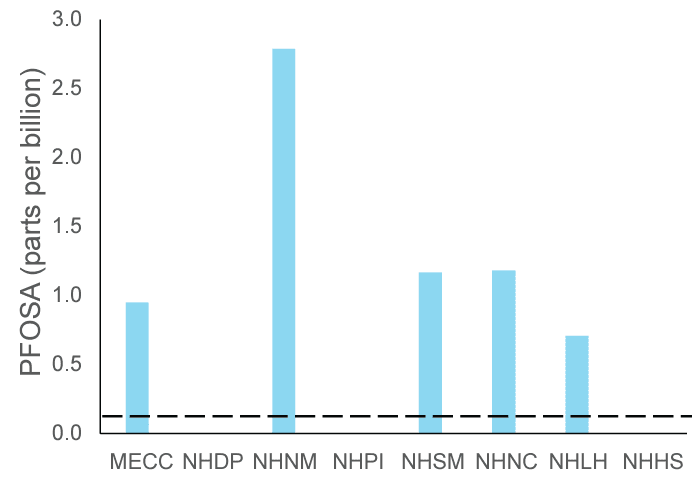Toxic Contaminants
Toxic Contaminants
How much toxic contamination is in blue mussel tissue and how has it changed over time? What is the status of mercury in sediments? What are contaminants of emerging concern and what do we know about their impacts on ecosystems and human health?
In blue mussel tissue, most concentrations of inorganic (e.g., heavy metals such as mercury and lead) and organic (e.g., polychlorinated byphenyls (PCBs)) chemicals from 1993 – 2016 were declining or not changing. Mercury concentrations in sediments were highest in Great Bay, the Piscataqua River, and Portsmouth Harbor; lowest values were found in Hampton Harbor . No trends were detected in time series beginning in 2000. Contaminants of emerging concern, per- and poly-fluoroalkyl substances (PFAS), pharmaceuticals, and personal care products, were widely detected. There are no regulatory advisories for these chemicals currently, but research and monitoring are ongoing.
The 2018 State of Our Estuaries report noted that most legacy contaminants — metals, pesticides, polycyclic aromatic hydrocarbons (PAHs), and polychlorinated biphenyls (PCBs) — showed either decreasing or no overall trends from 1993 through the year 2014. Two additional years of data from 2015 and 2016 resulted in no change for 26 contaminants, five changed from no trend to decreasing, and five contaminants changed from decreasing to no trend (Table 21.1). No contaminants were added to the “increasing” category. In addition, none of the recent data have exceeded US Food and Drug Administration “tolerance” or “action” levels for mercury or PCBs in shellfish and seafood (Figure 21.1).
Determining concentrations of contaminants in sediment is another useful way to track where contaminants end up in the Piscataqua Region Watershed. The EPA conducted surveys throughout the United States as part of the National Coastal Condition Assessment, collecting data in 2000 – 2006, 2010, and 2015 on toxic contaminants in sediments and fish tissue. In sediments, mercury concentrations ≥ 0.7 µg/g are considered likely to cause adverse health effects, while levels ≤ 0.13 µg/g are not.67 Results indicate that the possibility for adverse effects exist throughout the Great Bay Estuary, whereas the Hampton-Seabrook Estuary’s levels of mercury are lower and therefore less likely to cause adverse effects (Figure 21.2).
Apart from legacy contaminants, researchers are working to understand the presence and potential ecosystem and human health impacts of contaminants of emerging concern, including the family of chemicals referred to as PFAS. PFAS can be released from wastewater treatments facilities, current and former military sites due to firefighting foam use, and other runoff sources due to widespread use of these chemicals. In blue mussel tissue, PFAS (as PFOSA) were detected at five of eight sites in the Piscataqua Region Watershed, including Little Harbor (NHLH), New Castle (NHNC), North Mill Pond (NHNM), South Mill Pond (NHSM), and Clark Cove (MECC; Seavey Island, Portsmouth Naval Shipyard) sites, but not at Hampton-Seabrook Harbor (NHHS), Dover Point (NHDP), or Peirce Island (NHPI) (Figure 21.3).68
Currently, there are no published PFAS thresholds for ecosystem health, but there are thresholds for human health in terms of consuming shellfish and finfish. Based on recent sampling efforts, NHDES concluded that a shellfish consumption advisory for PFAS was not warranted69 but advisories for finfish may be necessary in the future as state and academic partners investigate further. This is because PFAS tends to accumulate as they travel up the food chain to bigger organisms, especially in finfish. PFAS toxicity, their regulation, and their occurrence across New Hampshire is an evolving situation so people with concerns should check the latest news at the NHDES PFAS Response website (https://www.pfas.des.nh.gov/).
In addition to PFAS, blue mussel samples were analyzed for many other potentially harmful contaminants of emerging concern compounds, including current-use pesticides, pharmaceuticals, personal care products, and flame retardants. Many of these contaminants of emerging concern were not detected at the eight Piscataqua Region Watershed sites. However, a number of pharmaceuticals and personal care products were detected. DEET, a common insect repellent, was found at all eight sites, although concentrations were well below levels associated with adverse effects.70
Future reports will contain more information on trends over time as well as potential impacts on ecosystem and human health.
Acknowledgment and Credits
Stephen Jones (NH Sea Grant/UNH) and Maria Florencia Fahnestock (UNH), with contributions from Kalle Matso (PREP).

Figure 21.1: Average concentrations (parts per billion dry wt.) of PCBs in blue mussel samples from Dover Point (NHDP) from 1994 to 2016. Data source: NOAA Mussel Watch Program /Jackson Estuarine Laboratory, UNH

Table 21.1. Trends in contaminant concentrations in mussel tissue in Clark Cove, Portsmouth Harbor (MECC), Dover Point (NHDP), and Hampton Harbor (NHHS), 1993 – 2016. Data source: Jackson Estuarine Laboratory, UNH

Figure 21.2: Distribution of sediment mercury concentrations in Piscataqua Region Watershed estuaries and tributaries from National Coastal Condition Assessment surveys 2000 – 2006, 2010, and 2015. Concentrations >0.7 µg/g (orange) are considered likely to cause adverse effects; at levels <0.13 µg/g (light green), effects are not expected. Intermediate concentrations between 0.13 – 0.7 with less defined risk are shown in yellow. Data source: National Coastal Condition Assessment, EPA

Figure 21.3: PFOSA concentrations (parts per billion, wet weight) in blue mussel tissue detected at monitoring sites in the Piscataqua Region Estuaries (see narrative on page 101 for site names). Dotted line represents the minimum weight corrected detection limit. Perfluorooctane sulfonamide (PFOSA) was the most frequently detected of the PFAS contaminants in this study, which used samples collected in 2015 and 2016 throughout the Gulf of Maine. Data source: NOAA Mussel Watch Program/ Jackson Estuarine Laboratory, UNH
Toxic Contaminants – Extended Report
Includes methods, data, and additional discussion not included in the Printed Edition.